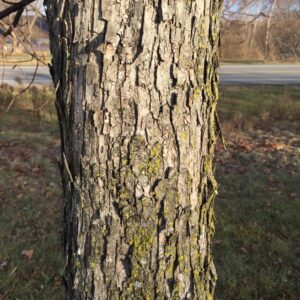SMA 2019 Urban Tree of the Year

Compiled by Michelle Sutton
Each fall, Society of Municipal Arborists (SMA) members vote for the Urban Tree of the Year. In 2019, members are elevating American hophornbeam (Ostrya virginiana), a very tough tree with subtle, often underappreciated beauty. It is a medium-sized tree in the birch family that has an extensive native range east of the Rockies, from Manitoba to Florida.

“Ostrya virginiana has common names that include American hophornbeam, Eastern hophornbeam, hornbeam, ironwood, leverwood…a poster child for why common names can be a problem,” said Cornell Urban Horticulture Institute Director Nina Bassuk. Bassuk describes Ostrya as an understory tree that is distinctive for its bark, which looks like thin, evenly spaced stringy strips lightly exfoliating from the trunk.
“When we urban foresters bring it out of the forest and onto the street, it makes a generally oval to rounded tree, about 30 feet (9.1 m) tall at maturity, with somewhat downward drooping branches,” said Bassuk. “The distinctive hop-like flowers that give Ostyra its common name are most numerous when it has some sunlight, but the tree grows well in light shade, too.”

Although it manages dry periods in the shade of the forest, it is not particularly drought-tolerant on the street. However, Bassuk says that at the Urban Horticulture Institute (UHI), they have found that Ostrya tolerates a wide soil pH range and is pest-free, making it well worth consideration.
Transplanting Ostrya can be a bit touchy, but planting small caliper and bare root in the fall is the most economical way to go. “Our UHI research on transplantability of Ostrya virginiana agrees with others that it is difficult to transplant successfully,” Bassuk says. “In our study, small-caliper (1.5 inch/38 mm) trees showed significant transplant shock in the first year after planting but then recovered in their second year. B&B trees transplanted better in the spring than bare root trees, while B&B and bare root trees transplanted equally well in the fall. Regardless of production method or season, small-caliper trees would be recommended when transplanting.”

Virginia Tech Associate Professor of Urban Forestry Eric Wiseman is a big fan of Ostrya, which ishardy in zones 3 through 9A. “For arborists, the attraction of hophornbeam goes beyond its outward appearance, for it fills a gap in the plant palette where few other native species have similar traits,” said Wiseman. “Here in Virginia, it is a fairly slow-growing species that reaches up to 40 feet (12.2 m) at maturity. Because it tolerates a wide range of soil conditions, it’s a good candidate for planting in narrow tree lawns, sidewalk cutouts, and parking lot buffers throughout most of the conterminous United States and southern Canada.” Wiseman shares that on the Virginia Tech campus, hophornbeam was the tree of choice for an outdoor dining area on the south side of the student center, where both above- and below-ground space were at a premium, yet shade and ambience were for critical to diners’ comfort.

“Hophornbeam wood is strong and the tree naturally takes on an excurrent growth habit with well-spaced, subordinate scaffold branches,” Wiseman said. “As such, it requires minimal structural pruning and holds up well in storms and busy urban environments. Given its slow growth rate, transplanting and aftercare require attention and patience. But once established, hophornbeam has few serious pest or disease problems.”
City of Southlake, Texas Landscape Administrator Keith Martin grew up with American hophornbeam in Houston and East Texas. “I nominated it simply because I think it should be used more in urban landscape settings, including my part of North Texas,” Martin said. “From my observation of hophornbeam in East Texas and Arkansas, it grows in a wide variety of soils, has strong wood, seems to be very drought tolerant, and has distinguishing yellow fall color. I think it would make an excellent ornamental, understory, or accent tree to be planted in place of other trees that are regularly overplanted in the South like red bud (Cercis canadensis), Mexican plum (Prunus mexicana), crape myrtle (Lagerstroemia spp.), and Yaupon holly (Ilex vomitoria).”
Michelle Sutton is editor, City Trees, the magazine of the Society of Municipal Arborists.
The SMA 2019 Urban Tree of the Year designation recognizes the underutilized, attractive, and useful American hophornbeam (Ostrya virginiana) for its service to urban forests and encourages its use when matched appropriately to site and as part of a diverse urban tree inventory. You can see the full list of past Tree of the Year winners on the SMA website.
Top photo: Ostrya virginiana catkins. This monecious tree bears both male and female catkins on the same tree. Photo by Ethan Dropkin



